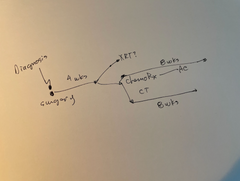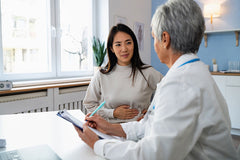Introduction
Chemotherapy is a powerful treatment that can save lives, but it’s not without its challenges. For many, joint and muscle pain after chemotherapy is one of the lingering effects. This pain can make everyday tasks feel daunting and disrupt your quality of life. While this is a common side effect, the good news is there are ways to address and manage it effectively. Whether through home remedies, medical treatments, or preventive measures, relief is within reach. Here, I’ll share insights and tips I’ve gathered from my own experience with chemotherapy and the recovery process validated by our Chief Medical Officer, Dr. Doug Blayney.
Want more information about cancer testing? Want to connect with support to help you through the cancer experience? Click here to learn more about Your Interactive Cancer Maps, our step-by-step guide to help you navigate the cancer experience and find the support your need from diagnosis to living with “the new normal” after treatment. Learn more here.
Understanding the Causes
Joint and muscle pain after chemotherapy can stem from various factors:
- Chemotherapy-Induced Inflammation: Chemotherapy targets fast-growing cells, including cancer cells, but it can also affect healthy cells. This can trigger inflammation in the body, leading to pain in joints and muscles.
- Neuropathy as a Side Effect: Nerve damage, or neuropathy, is a common side effect of some chemotherapy drugs. It often causes tingling, numbness, and pain that can extend to the muscles and joints.
- Loss of Muscle Mass Due to Prolonged Inactivity: During treatment, fatigue and physical limitations can lead to decreased activity levels. This inactivity can result in muscle loss, making movements feel more painful or difficult.
- Hormonal Imbalances Contributing to Pain: Certain chemotherapy drugs can affect hormone levels, which may indirectly cause joint discomfort and stiffness.
Understanding the root cause of your pain can help guide the right treatment and lifestyle adjustments.
Home Remedies and Lifestyle Tips
Some of the simplest remedies can provide significant relief for joint and muscle pain. These approaches focus on improving mobility, reducing inflammation, and promoting overall well-being:
- Gentle Exercises: Activities like yoga, stretching, or light walking can help maintain flexibility and reduce stiffness. Start slow and listen to your body, gradually building strength over time.
- Warm Compresses and Epsom Salt Baths: Applying a warm compress to sore areas or soaking in an Epsom salt bath can relax muscles and ease pain. The magnesium in Epsom salts may help reduce inflammation.
- Anti-Inflammatory Diets: Incorporate foods rich in omega-3 fatty acids, like salmon or walnuts, along with leafy greens and colorful vegetables. These foods can help combat inflammation naturally.
- Adequate Hydration: Staying hydrated helps flush toxins from the body and reduces inflammation, supporting your body’s recovery.
Medical Treatments
If home remedies don’t provide enough relief, there are medical treatments that can help:
- Prescription Medications: Your doctor may prescribe medications to address neuropathy or reduce inflammation. Always take these under medical supervision to ensure safety.
- Physical Therapy: Working with a physical therapist can help restore strength and mobility in your muscles and joints. They can tailor exercises to your specific needs and limitations.
- Non-Invasive Treatments: Techniques like acupuncture and massage therapy have been shown to relieve pain for some people. These treatments may also help improve circulation and reduce stress, which can further ease discomfort.
Pain Management Techniques
Managing chronic pain often requires a combination of strategies. In addition to medical and home-based approaches, consider these techniques:
- Over-the-Counter Pain Relievers: Medications like ibuprofen or acetaminophen can be helpful but should only be used under your doctor’s guidance to avoid interactions with other treatments.
- Mindfulness and Meditation: Relaxation techniques can shift your focus away from pain and help you feel more at ease. Apps and guided videos can make this practice more accessible.
- Cognitive-Behavioral Therapy (CBT): A therapist trained in CBT can help you develop strategies to manage chronic pain and cope with its emotional impact.
When to Seek Medical Advice
Sometimes, pain may be a sign of something more serious. Here are a few situations where you should consult your healthcare provider:
- Severe Pain: Pain that doesn’t improve with basic measures or interferes significantly with daily life could signal a complication.
- New or Worsening Symptoms: Sudden swelling, redness, or intense pain should be evaluated to rule out infections or other issues.
Open communication with your oncologist is essential. They can adjust treatments or recommend additional therapies to help manage your symptoms effectively.
Preventive Measures Post-Chemotherapy
While you can’t always prevent side effects, certain habits can reduce the risk or severity of joint and muscle pain:
- Regular Physical Activity: Staying active after treatment helps rebuild strength and prevents stiffness. Even simple activities like walking or gentle yoga can make a big difference.
- Balanced Nutrition: Eating a variety of nutrient-rich foods supports overall recovery. Include lean proteins, whole grains, and plenty of fruits and vegetables in your diet.
- Routine Check-Ups: Regular follow-ups with your healthcare team allow them to monitor lingering side effects and address concerns early.
Cancer Maps to help you find your way, one decision at a time.Built for Patients, by Patients. Backed by World-Leading Oncologists

Join a community of people who “get it”
The Manta Cares team is composed of cancer survivors, caregivers, oncologists and nurses - so we truly understand the challenges that come with a cancer diagnosis because we’ve been there. We are here to walk with you as you go through your own cancer experience. Please don’t hesitate to reach out with any questions. We have even developed Your Interactive Cancer Maps, a platform with disease-specific step-by-step maps to show you all the paths you might face during your cancer experience, future treatment options and connect you with relevant support and resources. Sign up for access to the Your Interactive Cancer Maps platform here.
Be sure to subscribe to our newsletter and check out our free resources like our Chemotherapy Checklist for Caregivers, Financial Checklist for Cancer Treatment and more. We also put out a bi-weekly podcast called the Patient from Hell to educate, empower and hopefully inspire you as you go through this crappy experience. You can listen on Spotify, Apple Podcasts, YouTube or anywhere you listen to podcasts. Dealing with cancer as a patient or caregiver can feel really lonely. Just know that you are not alone in this experience.
Also Read:
- TCHP Chemo: Which Days Are the Worst?
- Side Effects of AC followed by Taxol Chemotherapy
- Chemotherapy vs. Immunotherapy for Lung Cancer
- Why Do Aromatase Inhibitors Cause Insomnia?
- Importance of Wearing a Compression Bra After Breast Surgery
- 5 Dental Side Effects Of Tamoxifen, Chemo and Bone Drugs
- How to Sleep with a Chemo Port
- Taking A Break From Tamoxifen: When, Why and What To Expect
- Can Claritin Help With Joint Pain From Breast Cancer Treatment?
Conclusion
Joint and muscle pain after chemotherapy can feel overwhelming, but it’s important to remember that relief is possible. With a combination of home remedies, medical treatments, and preventive care, you can take steps to feel better and regain control over your daily life. Don’t hesitate to reach out to your healthcare team for guidance tailored to your needs. They’re there to help you every step of the way.
FAQs for Joint and Muscle Pain After Chemotherapy
Q: How to ease joint pain after chemo?
Ans - Gentle exercises, warm compresses, and anti-inflammatory diets are great places to start. Consult your doctor for additional treatments if needed.
Q: What is the 7-day rule for chemotherapy?
Ans - The “7-day rule” often refers to how long side effects may last after a chemotherapy session. It’s a general guideline, but symptoms can vary by individual.
Q: How to ease chemotherapy side effects?
Ans - Rest, hydration, balanced nutrition, and staying active can help ease many side effects. Talk to your doctor about medications or therapies for specific issues.
Q: Why does my body hurt so bad after chemo?
Ans - Chemotherapy can cause inflammation, neuropathy, and hormonal changes that lead to pain. Inactivity during treatment may also contribute.
Q: How can I stop my legs from hurting after chemo?
Ans - Try light stretching, warm baths, or gentle massages. Physical therapy and pain relievers may also help, under a doctor’s supervision.
Q: What is the best thing for joint pain and stiffness?
Ans - Regular movement, anti-inflammatory foods, and warm compresses can alleviate stiffness. For more severe pain, seek medical advice for tailored treatments.
Disclaimer: All content and information provided in connection with Manta Cares is solely intended for informational and educational purposes only. This content and information is not intended to be a substitute for medical advice, diagnosis, or treatment. Always seek the advice of your physician or other qualified health provider with any questions you may have regarding a medical condition.




